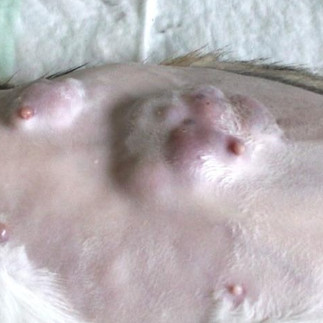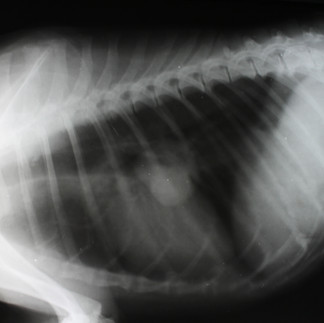Breast cancer in dogs and cats
- Dr Andrew Matole, BVetMed, MSc

- Aug 9, 2021
- 5 min read
Updated: Aug 24, 2021
Introduction

Breast cancer occurs most commonly in older, intact female pets. While the cause of breast cancer is unknown, hormones are thought to play a role. Usually, these are suspected during a physical examination by the veterinarian when a mass is detected in the rear abdominal mammary glands (dogs) and front thoracic mammary glands (cats) respectively.

The dog is by far the most frequently affected pet, with an occurrence that is three times that in women. About 50% of all cancers in the bitch are mammary tumours. Approximately 45% of breast cancers in dogs are malignant, ie, they spread to other parts of the body, whereas in cats about 90% are malignant.
What is breast cancer?
Breast cancer refers to the uncontrolled growth of abnormal mammary gland (breast) tissue. When left untreated, the breast cancer cells can spread to other mammary glands, lymph nodes, the lungs, and other organs throughout the body. The development of mammary tumours in dogs and cats is most often common in older, female dogs and cats that have not been spayed. 50% of mammary masses in dogs are malignant.
What is the cause of breast cancer in dogs and cats?
The exact cause of mammary gland cancer is unknown in many instances. However, the following are the probable causes:-
Hormones

Hormones play an important role in the development of mammary tissue cancer, but the exact mechanism is unknown. Dogs and cats that are spayed, however, before their first heat cycle are less likely to have breast cancer, confirming that hormones may play a role. Treatment with hormones for other conditions may increase the risk for this type of cancer.
Genetics

Genetics also play a role in canine and feline breast cancer with recent findings showing that certain genes are overexpressed in dogs and cats with this condition.
Lifestyle

It has also been demonstrated that the consumption of red meat, obesity at one year of age, and obesity a year before diagnosis are associated with an increased risk of mammary gland tumours in intact or spayed dogs.

What are the signs of breast cancer in dogs and cats?
Signs of breast cancer include firm nodules in the tissue around the nipples, ulcerated skin, and swollen, inflamed nipples with or without discharge. Feeling alone cannot determine whether a lump is cancerous or not. Any lump in the mammary area has the potential to be cancerous, so it's a good idea to check your pet regularly.
Mammary tumours tend to be firm, nodular masses under the skin. Tumours may be located in a single mammary gland (the area around one nipple), or they may be in several mammary glands at once. The skin covering the tumour may be ulcerated or infected. Nipples may be swollen or red, and there may be discharged from the nipple itself.
How is breast cancer diagnosed in dogs and cats?

Breast cancer is best diagnosed with a surgical biopsy. Blood work and radiographs (x-rays) are usually recommended to help determine if the cancerous cells have spread to other parts of the body.
In dogs with large masses, it may be possible to obtain a fine needle aspirate of the tumour, which involves placing a needle into the mass and extracting cells for examination under the microscope. This procedure may be more difficult with smaller masses or in cats. Since a biopsy usually provides a larger tissue sample (likely to yield a more definitive diagnosis), this is the best option. Biopsies generally require some form of anaesthesia or sedation, so your vet may recommend a pre-anaesthetic evaluation and/or blood work.
How is breast cancer treated in dogs and cats?

Surgery
Early detection and surgically removing the masses is the best treatment option. Before performing surgery, it is recommended that blood work and radiographs (x-rays) are done. Chest radiographs are important to check for any cancer that could have spread to the lungs, and abdominal x-rays may show signs of enlarged lymph nodes. If the radiographs show no evidence of spreading, the pet has a better prognosis. Submission of the tissue for microscopic examination will determine if the tumours have been completely removed. Surgical removal of the tumour with the regional lymph node will increase disease-free time but, in cases of malignancy, may not increase survival time.
Radiotherapy & Chemotherapy

Radiation therapy or chemotherapy are usually considered and carried out after surgery as adjuvants. Radiation therapy is administered to kill any remaining potentially cancerous cells in a focused area.

Chemotherapy involves the administration of systemic drugs that treat cancerous cells that may have spread to other parts of the body. The drugs involved in chemotherapy include deracoxib, doxorubicin, cyclophosphamide, vincristine or a combination of deracoxib and doxorubicin or doxorubicin and cyclophosphamide.
How can breast cancer be prevented in dogs and cats?
The best way to prevent breast cancer in pets is to have the pet spayed before her first heat cycle. Even spaying a pet by 1 year of age can help reduce breast cancer risk. Pets that are spayed later in life are still at a higher risk for breast cancer.

References
Kutzler, M. (2020). Mammary Tumors in Dogs and Cats. In M. S. Corp., Merck Veterinary Manual. New Jersey, USA: Merck Sharp & Dohme Corp.
Hassan, B. B., Elshafae, S. M., Supsavhad, W., Simmons, J. K., Dirksen, W. P., Sokkar, S. M., & Rosol, T. J. (2017). Feline Mammary Cancer. Veterinary pathology, 54(1), 32–43. https://doi.org/10.1177/0300985816650243
De Araújo, M. R., Campos, L. C., Ferreira, E., & Cassali, G. D. (2015). Quantitation of the regional lymph node metastatic burden and prognosis in malignant mammary tumors of dogs. Journal of Veterinary Internal Medicine, 29(5), 1360-1367.
Lim, H. Y., Im, K. S., Kim, N. H., Kim, H. W., Shin, J. I., Yhee, J. Y., & Sur, J. H. (2015). Effects of obesity and obesity-related molecules on canine mammary gland tumors. Veterinary pathology, 52(6), 1045-1051.
Tran, C. M., Moore, A. S., & Frimberger, A. E. (2016). Surgical treatment of mammary carcinomas in dogs with or without postoperative chemotherapy. Veterinary and comparative oncology, 14(3), 252-262.
Kristiansen, V. M., Nødtvedt, A., Breen, A. M., Langeland, M., Teige, J., Goldschmidt, M., ... & Sørenmo, K. (2013). Effect of ovariohysterectomy at the time of tumor removal in dogs with benign mammary tumors and hyperplastic lesions: a randomized controlled clinical trial. Journal of Veterinary Internal Medicine, 27(4), 935-942.
Sorenmo, K. U., Kristiansen, V. M., Cofone, M. A., Shofer, F. S., Breen, A. M., Langeland, M., ... & Goldschmidt, M. H. (2009). Canine mammary gland tumours; a histological continuum from benign to malignant; clinical and histopathological evidence. Veterinary and comparative oncology, 7(3), 162-172.
Chang, S. C., Chang, C. C., Chang, T. J., & Wong, M. L. (2005). Prognostic factors associated with survival two years after surgery in dogs with malignant mammary tumors: 79 cases (1998–2002). Journal of the American Veterinary Medical Association, 227(10), 1625-1629.
Karayannopoulou, M., Kaldrymidou, E., Constantinidis, T. C., & Dessiris, A. (2005). Histological grading and prognosis in dogs with mammary carcinomas: application of a human grading method. Journal of comparative pathology, 133(4), 246-252.
Alenza, M. D. P., Tabanera, E., & Peña, L. (2001). Inflammatory mammary carcinoma in dogs: 33 cases (1995–1999). Journal of the American Veterinary Medical Association, 219(8), 1110-1114.
Stockhaus, C., Kohn, B., Rudolph, R., Brunnberg, L., & Giger, U. (1999). Correlation of haemostatic abnormalities with tumour stage and characteristics in dogs with mammary carcinoma. Journal of small animal practice, 40(7), 326-331.
Sorenmo, K. U., Worley, D. R., & Goldschmidt, M. H. (2013). Tumours of the mammary gland. In Withrow and MacEwen's small animal clinical oncology (pp. 538-556). WB Saunders.



















Comments